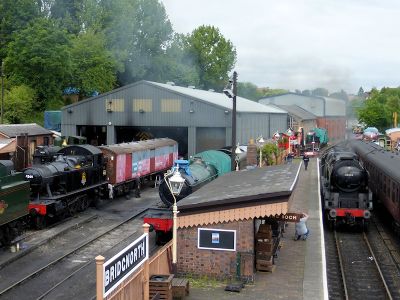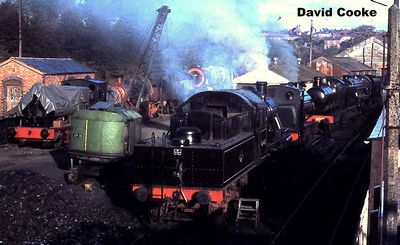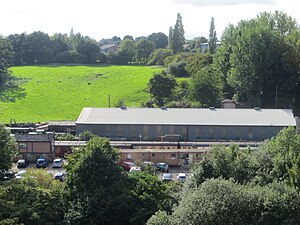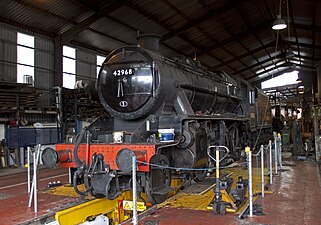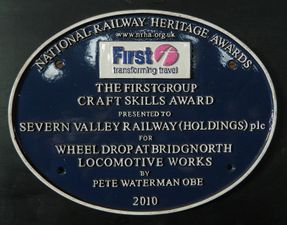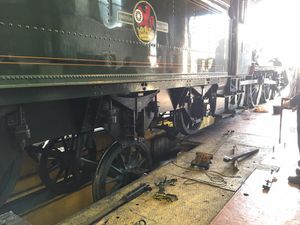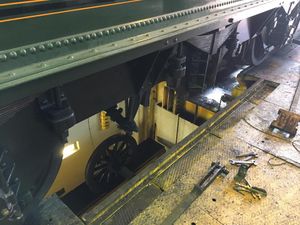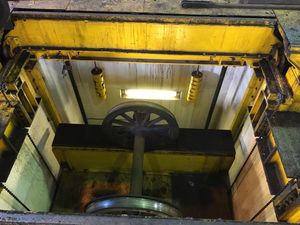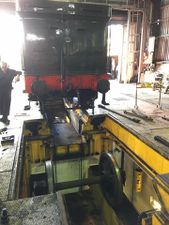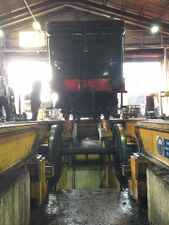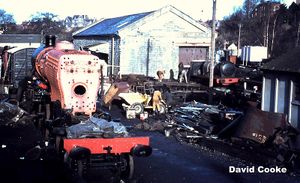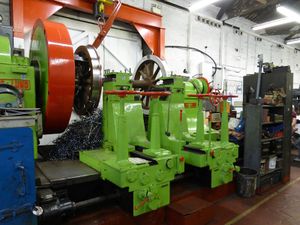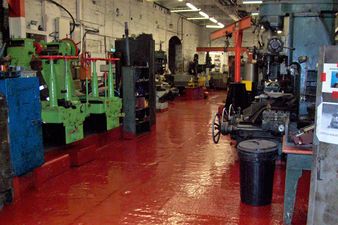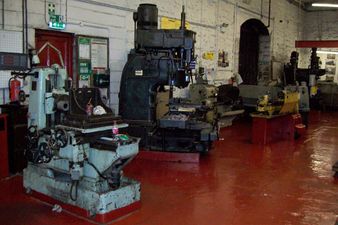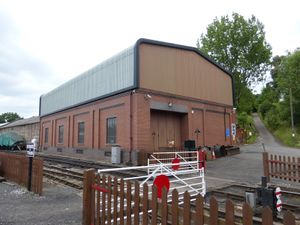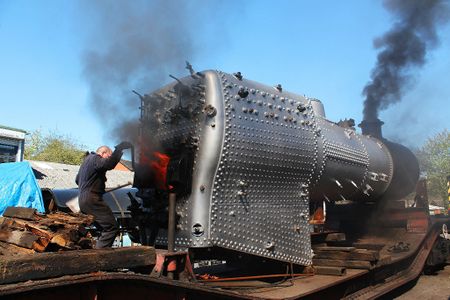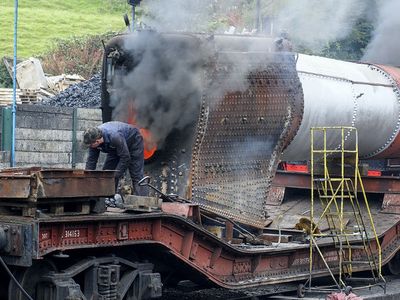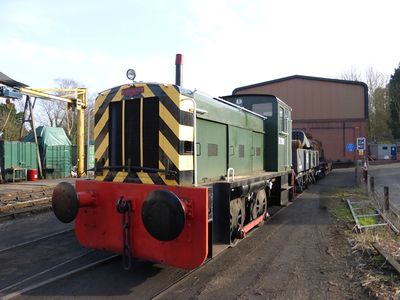Bridgnorth Loco Works
Bridgnorth Loco Works is the home to Severn Valley Railway Engineering Services and is the SVR's main steam locomotive maintenance, repair and restoration facility. The Loco Works forms part of the Bridgnorth MPD and mainly occupies four buildings, the Loco Shed (ex-Portskewett), the Machine Shop (formerly the GWR Goods Shed), the Paint Shop (ex-Heaton Mersey diesel depot) and the Boiler Shop. There is also a pattern shop, where patterns for castings are made and stored.
The Loco Works is normally closed to the public, although the Loco Shed and Machine Shop may be open for viewing during Gala events such as the Open House Weekend.
Contents
Loco Shed
When preservation began, the former Bridgnorth goods shed was initially used as a loco shed although it was very restricted in size. In spring 1972 the SVR Company purchased the ex-B.R. Diesel Depot building at Heaton Mersey, Stockport.[1] Later that year a large disused building at Portskewett, near Severn Tunnel Junction, was also identified as a possible loco shed building.[2] When the latter building was acquired in 1974, it was planned to begin construction using the Heaton Mersey building, with the Portskewett shed potentially being destined for the Stourport Triangle.[3] However when construction of the loco shed began in March 1976, it was done using parts of the former Portskewett Shed, with the pits being dug the following November and the building completed in April 1977.[4] The ex-Heaton Mersey shed was added in 1978 to the rear of the ex-Portskewett Shed, adjacent to the Goods Shed.[5]
The small brick building on the left in the main pictures above pre-dates preservation and is used an oil store. Two other BR-era buildings in front of the Goods Shed seen in the 1972 view were demolished shortly afterwards to make way for the 'new' loco shed.
In autumn 1990 the "Wash & Brush Up LNER Style" SVRA raffle raised money for new amenities for the Works[6].
Wheel drop
The loco shed includes a wheel drop which was formerly located at the Leicester Midland MPD (shed 15C). This was purchased and installed following an appeal for funds launched in summer 2009. Installation involved digging a hole 6m deep, relocating a mains water pipe and pouring 200m3 of concrete.[7] The wheel drop won the National Railway Heritage Awards FirstGroup Skills Award in 2010.[8]
The newly-installed wheel drop was used 'in anger' for the first time on 29 July 2010, when the trailing driving wheel set was removed from Stanier mogul 42968 to attend to loose axle boxes.[9] This series of photos shows the wheel drop in use to remove a tender wheelset from GWR 7802 Bradley Manor
2009 upgrade project
An upgrade to the loco shed was also carried out in 2009, including the installation of roller shutter doors, side windows to improve lighting, and the provision of an enclosed paint shop within the ex-Heaton Mersey building.
2022 upgrade project
By 2020 the loco shed roof was leaking and was thought to have only a two year lifespan. Lighting in the works was also considered inadequate, and there was no fit-for-purpose method of moving heavy items. A capital project planned for 2020-2021 was initially put on hold due to the effects of the 2020 coronavirus disease (COVID-19) pandemic.[10] The Charitable Trust's planned appeal in 2020 was deferred for the same reason.[11]
The project included:
- A new roof with insulated panels, with at least 15% translucent to maximise daylight.
- Environmental measures including water harvesting and LED lighting to give full illumination throughout the building.
- Installing an 8-tonne overhead travelling crane, allowing heavy items to be moved safely and with ease.
In early 2021 the Charitable Trust launched its "Home and Dry appeal". The project was the subject of the spring 2021 "Home and Dry" raffle.[12][13]
The quoted cost of the project escalated. SVR News Winter 2020 quoted a figure of £80,000. The Charitable Trust's planned 2020 appeal had aimed to raise £250,000. The Home and Dry appeal was for a revised project cost of £425,000, later increased to £475,000 because of the 'spiralling cost of steel and additional improvements that are needed inside the works'.[14] On 25 January 2022 the Charitable Trust announced that the whole £475,000 had been raised.[15] A small further appeal of £15,000 covered improved epoxy resin flooring.[16]
Contractors arrived on site in April 2022, with areas out of bounds including the main locomotive shed and paint shop. A second-hand 6.3 ton capacity crane and supporting steel structure were installed as part of the works.[17] The works were completed on time and on budget.[16]
Alan Reade produced limited edition prints of the shed, presented to key volunteers who worked on the project[18].
Machine Shop
The Loco Works' machine shop is located in the former Bridgnorth Goods Shed adjacent to the loco shed. The brick-built shed can be seen in this 1973 view; the corrugated shed which stood in front of it and is visible in the 1972 view above was in course of demolition at the time.
The machine shop includes a Noble and Lund wheel lathe, acquired from BR’s Derby Loco Works in 1972.
Boiler shop
The George William Knight Boiler Repair Shop is situated to the rear of the machine shop and loco shed.
Construction
Before the boiler shop was built, riveting of boilers was done outdoors. Following complaints by neighbours, Bridgnorth District Council unexpectedly served a noise abatement order on the Railway on 25 March 1986 ordering it to stop riveting boilers in the open air.[19] The Railway lodged an appeal, and a Crown Court hearing on 11 July overturned the injunction. At the same time the SVR applied for, and in November 1986 was granted, a two-year temporary planning permission allowing day-time open air working.[20] The SVR launched a share offer in 1988 to raise £500,000 for construction of the new boiler shop, the largest capital project since the first phases of Kidderminster Town station. Reasons for the high cost included soundproofing using brick and breeze block walls and special doors and windows, and pile driven foundations to take the weight of a substantial 30-ton overhead crane.[21]
October 1988 saw "…an orgy of boiler smithing" as the boilers from 5764, 4566, 42968 and 7802 were all completed and the site then cleared. The contract for construction was let, with work commencing on 21 November 1988 and a target completion date of April 1989. The main contractors were Hickmans of Wolverhampton; the principal sub-contractors were Rubery Owen Steelwork for the frame of the building / crane rails and Davy Morris of Loughborough for the overhead gantry crane.[22] Some delays were incurred in construction, but the building was sufficiently complete by the August bank holiday for it to be used as a temporary paint shop for varnishing BR 16267. Boiler work in the shop commenced later in 1989.[23]
The official opening ceremony was performed by HRH The Duke of Gloucester on 29 October 1990. It was named after George Knight, former deputy chief boiler inspector of British Railways London Midland Region based in Derby, who regularly gave up his time to train the Railway's earliest paid staff. Sadly, he died before the boiler shop was completed.
In 2012 Severn Valley Railway Engineering Services took delivery of a CNC lathe to help with mass production of stays in the workshops, for SVR and contract use.
2011 Copper theft
On 20 January 2011 thieves stole copper sheets worth between £50,000 and £70,000 in a ‘pre-planned and highly professional’ raid, one of a series of major losses targetting copper at a number of heritage sites in that period. Thieves had made an unsuccessful attempt 24 hours earlier, as a result of which the SVR immediately brought in specialist security advisors. However the gang broke in the following night using two ladders - one propped on top of another - to smash the security alarm 16 feet up on the outside wall of the building, and broke down the reinforced air-vent grille to gain access. They then hot-wired the 30-ton capacity overhead gantry crane, using it to lift eleven copper sheets weighing an estimated six tons in total into a lorry which they had reversed into the building.[24] The theft, believed to have taken place some time after midnight, was discovered by SVR loco driver and permanent way man Bob Toy at around 7.30am the following morning.
The copper sheets had been cut to size and designated as new/replacement sections for the fireboxes of several locomotives, including 82045, 47383 and 48773. In addition, they stole a made-up outside steam pipe from 1501 and the chains from the gantry crane. Workflow was not interrupted as the locomotives involved were not at that time being worked upon.
Scene of Crime officers from West Mercia Police studied scrapes on the wall, thought to have been caused by a vehicle and footprints in the dust on the floor. They also obtained CCTV footage of a heavily laden vehicle leaving Bridgnorth, with false registration plates. The railway offered a £5,000 reward for information leading to the recovery of the stolen copper, but to no avail, and the SVR's insurers met the cost of the stolen material in full. Following the raid, the SVR moved swiftly to install new security arrangements[25].
New boiler assembly and production
A development of contract engineering work has seen the SVR producing new boilers.
- 0-4-0 Back/Well Tank No. 2 'Dolgoch' from the Talyllyn Railway (no. 63/1866 by Fletcher, Jennings & Co). Severn Valley Railway Engineering at Bridgnorth announced in 2010 that they had been awarded the contract for the new boiler of traditional rivetted construction with a copper inner firebox. This boiler was SVR No. 1
- In 2016 a new boiler was completed for Samson, a replica for Beamish of a Stephen Lewin-built 0-4-0T originally constructed in 1874 at Lewin’s Poole Foundry.[26][27]
- In 2018 Engineering Services was awarded a contract to build five new boilers for the Isle of Man Railway. The first two were delivered in 2020 and the fourth and components for the fifth in 2023, completing that order.[28][29]
- BR 3MT 82045 - the SVR is assembling the boiler of the new locomotive of the Riddles BR 3MT 2‑6‑2T class
Contract boiler overhauls
Engineering Services also undertake contract overhauls for boilers of locomotives not resident on the SVR. An incomplete list includes:
- Quarry Hunslet 780/1902 ‘Alice’. Bala Lake Railway based locomotive received modifications with 3 washout mud doors, 2 re-located and tapped washout plug holes and 6 blanked off existing washout plug holes.[30]
- Andrew Barclay 0-4-0WT (works number 1995 of 1931) (2011). Ex-Burnhope Reservoir railway, later at Dinorwic Quarry where it became No. 70 'Caledonia'. Based at Hollycombe Steam Collection. See also 2021 entry below.[30]
- Furness Railway 150 'Cumbria' - Hunslet Austerity works no 3794, arrived at Bridgnorth Boilershop on 1 August 2011.
- Hawthorn Leslie 2859 (Tanfield Railway No. 2) delivered at Tanfield on 6 August 2012.[31]
- No. 441 - Thomas Green Works ‘Barber’ 2ft Gauge 0-6-2ST, completed in 2013. The firebox was made by South Devon Railway
- Welshpool & Llanfair No. 10 'Sir Drefaldwyn' 20 December 2013 to 21 May 2015.[32]
- IOMR locomotive No. 11 'Maitland' arrived in 2014, returning 15 January 2016.[33]
- Coffee Pot No. 1's boiler was sent to Bridgnorth for re-tubing in 2016.[34]
- Ivatt 2MT 2-6-2T No. 41241, Keighley & Worth Valley Railway. Completed December 2017.[35]
- IOMR locomotive No. 15 'Caledonia' in 2018 and No. 4 'Loch' started that year.[36]
- Penrhyn Slate Quarry No. 'Glyder' 0-4-0WT.[37]
- Quarry Hunslet 779/1902 ‘Holy War’, ex-Dinorwic Slate Quarry, No. 3 from the Bala Lake Railway.[38][39]
- Hollycombe Steam Museum Andrew Barclay 0-4-0WT No 1995 'Caledonia' (2021)[39]
- IOMR locomotive No. 12 'Hutchinson' had frame stretcher attention in the boilershop, and side tanks in the paintshop. The constituent parts and NB3 boiler returned to the Isle of Man in October 2023.
- The boiler of IOMR No. 16 'Mannin'.
Test of 43106's boiler outside the boiler works (K. Wilkinson)
Test of 7802 Bradley Manor's boiler at the front of Bridgnorth works (R. Westwood)
Boiler shop shunter
Ruston and Hornsby 165hp Diesel Electric Shunter D2961 normally serves as the Boiler Shop shunter.
See also
References
- ↑ SVR News 23
- ↑ SVR News 31
- ↑ SVR News 33
- ↑ SVR News 44
- ↑ SVR News 49
- ↑ SVR News 97
- ↑ Bridgnorth Wheel Drop case study on George Law's web site
- ↑ NRHA Awards 2010
- ↑ SVR News 170/171
- ↑ SVR(H) annual report and financial statements for the period ended 5 January 2020
- ↑ SVR Charitable Trust annual report and financial statements for the period ended 30 June 2020
- ↑ SVR News 212, 213
- ↑ Branch Lines, March 2021
- ↑ Branch Lines August 2021
- ↑ SVR Website (retrieved 18 February 2022
- ↑ 16.0 16.1 Branch Lines, August 2022
- ↑ Branch Lines November 2021
- ↑ SVR News 220
- ↑ SVR News 80
- ↑ SVR News 81
- ↑ SVR News 88
- ↑ SVR News 90, 91
- ↑ SVR News 94
- ↑ 'Gang steal Severn Valley Railway copper', BBC, 27 January 2011 (Retrieved 7 December 2020)
- ↑ SVRA forum thread, " PR: 'Professionals' target SVR in £70,000 copper plate theft", 27 January 2011 (Retrieved 15 April 2018)
- ↑ rail.co.uk, 20 May 2016 (Retrieved 13 April 2019)
- ↑ Beamish Transport Online, 20 November 2015 (Retrieved 13 April 2019)
- ↑ Branch Lines, December 2020
- ↑ Branch Lines, May 2021
- ↑ 30.0 30.1 Express Points web round up, August 2011
- ↑ Delivery of repaired boiler for Hawthorn Leslie 2859 (Tanfield Railway No. 2), YouTube 6 August 2012 (Retrieved 21 February 2013)
- ↑ SVR Engineering Twitter
- ↑ SVR Forum 15 January 2014
- ↑ Beamish Transport Online, 22 September 2016 (Retrieved 2 August 2019)
- ↑ Steam Railway Magazine, 3 December 2017 (Retrieved 13 April 2019)
- ↑ Isle of Man Today, 24 January 2018 (Retrieved 13 April 2019)
- ↑ SVR News 208
- ↑ Branch Lines December 2020
- ↑ 39.0 39.1 SVR213
